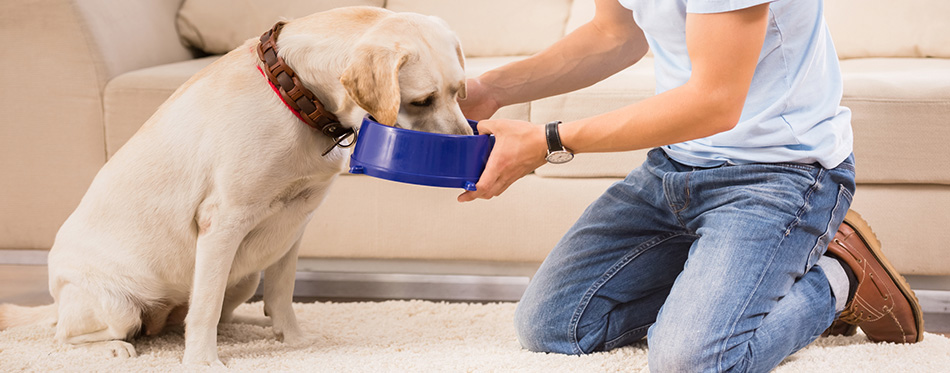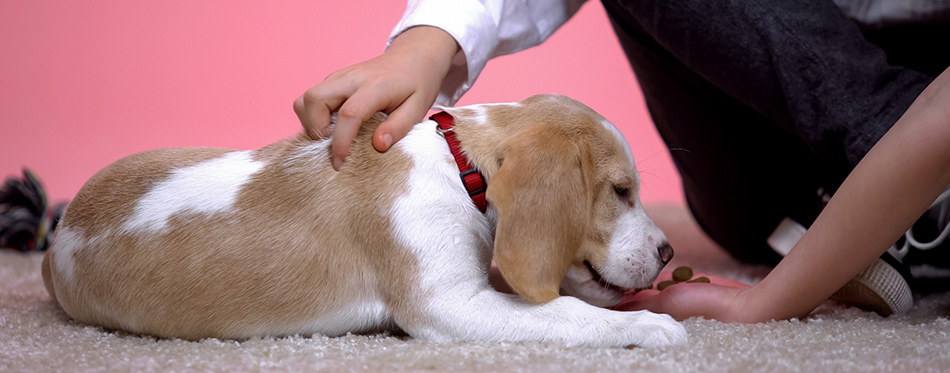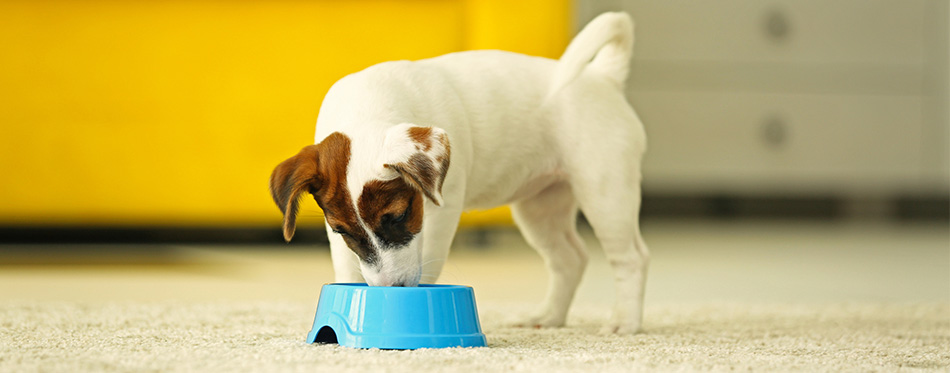Most dog owners pattern their pet’s feeding schedule after their own mealtimes. For instance, if the pet owner has breakfast at 7 in the morning, then the pet should have its chow, too. But is it appropriate to apply human mealtimes to our dogs? If not, then what is the best time to feed our canine friends?

Common Feeding Times for Dogs
Different pet parents observe different feeding schedules for their respective dogs. Some observe a twice-daily feeding schedule while others go for once-a-day feeding. There are also those that leave the feeding to their dogs, meaning it is “free choice”. Let us look at these feeding times one by one.
Twice-a-Day Feeding
Pet parents who observe a twice-daily feeding schedule will feed their dogs once in the morning and another in the evening. They often observe an 8- to 12-hour period in between meals. For instance, if you give your dog its breakfast at 7 in the morning, you can give its dinner at around 3 in the afternoon or 7 in the evening. This is typical for healthy adult dogs and follows the normal canine digestion.
The dog’s digestive system requires about 5 to 6 hours for it to process and absorb the food that it consumed. These nutrients will still be present in the dog’s blood for a few more hours before its stomach starts sending “hunger” signals to the brain. This occurs about 8 to 10 hours after the meal, depending on the amount of calories that the pet consumed in its last meal.
As early as 8 hours after its last meal, the dog’s brain receives the first “hunger” signals. These grow in intensity and can manifest in different dog behaviors telling you they are already hungry.
The timing of their first meal depends on a few considerations. One of these is their need to defecate. Canine fecal elimination occurs anywhere between 30 minutes to 1 hour after a meal. If you are going to work at 8 in the morning, this means you need to feed them at about 6:30 AM. This will give you ample time to take them out for a walk for them to defecate. You can then prepare for your work.
You can also observe the same consideration during their second and last meal of the day. You may want to feed them first before you walk them for a poop. The current recommendation is to make their evening walk longer so that they will also tire afterwards. This will help them go to sleep a lot faster. The timing, then, depends on what time you want to be on your own bed.
This twice-a-day feeding schedule is applicable to normal healthy adult dogs. Younger dogs such as puppies often require more frequent feedings. The same is true for dogs with certain health conditions.
Related Post: Automatic Dog Feeders
Once-a-Day Feeding
Proponents of once-a-day dog feeding schedule often feed their dogs in the evening. They will feed their dog upon coming home from work. After about 30 minutes or so, they can take their hound out for a long 30- to 60-minute walk.
There are also those who feed their dogs early in the morning, before they tend to their other life commitments. Again, the general guideline here is to feed the dog first before you facilitate their defecation.
Once-a-day feeding is not recommended among dogs that are prone to gastric dilatation volvulus. These include breeds like Great Danes, Weimaraners, St. Bernards, and Doberman Pinschers, among others. Veterinarians consider once-a-day feeding to be a major risk factor in the development of this life-threatening condition. In GDV, the dog’s stomach expands and twists on its own axis. This can lead to the cutting off of the blood supply to the organs of the abdomen.
If you are considering feeding your dog only once a day, make sure that it doesn’t have a deep and narrow chest. These dogs are more prone to GDV than any other breed.

Feeding Ad Libitum or Free Choice
There are also pet parents who feed their dogs ad libitum. This means it’s up to the dog to decide when it wants to eat. This approach is ideal for hyperactive dogs that may require frequent trips to their food bowl to replenish their energy. It may also work for nursing dams since they have plenty of small mouths to feed.
It is also the ideal solution for pet parents who may have difficulty adhering to a strict dog feeding schedule. All they need to do is to leave their pets with a bowl full of dog food and they can go on their merry way.
For this to work, the dog food should be in the form of kibbles. It is never a good idea to use canned or wet dog food in an ad libitum feeding approach. Dog kibbles take longer to spoil so your dog can still feast on its food at the end of the day.
The main issue with feeding your dog ad libitum is that it can increase the risk of health problems like GDV and obesity. Some dogs can finish a day’s supply of dog food in one sitting. This can make them develop bloat, a major precursor of GDV. If they don’t watch the amount of food they are taking, dogs can also become overweight. This is because some dogs have a knack for eating beyond satiety.
There can also be issues about the dog’s behavior. It may not want to share the food with the other dogs in the household.
Feeding Schedules for Other Dogs
The preceding section talks about the feeding schedule for a normal, healthy adult dog. However, there are certain dogs that may not do well with these feeding schedules. Let us look at them.
Puppies
When deciding on the mealtimes of puppies, it is important to consider its toilet training. This is almost the same with the elimination pattern of adult dogs. Potty-training puppies often entails taking them outside the house several times each day. Some puppies may have to go outside about 5 to 6 times every day. As such, you can intersperse your feeding schedule within these housetraining sessions.
Sleep is another factor in puppies that you should consider. Puppies can sleep from 16 to 20 hours every day. You will want to schedule their feeding time during the puppy’s waking hours.
The last factor that you need to consider is the puppy’s activity levels. In general, pups spend their energy in bursts rather than in a sustained manner. This means you can see them playing now and sleeping a few minutes later. This is because they have already used up their energy.
The current recommendation is to feed puppies at least 3 times a day. Younger puppies require more frequent feedings than their older counterparts.
For example, you can take them outside for a short walk right after waking up. After an hour, you can give it its first meal of the day. After 30 minutes, you can then take it out to defecate in the backyard. You can give its 2nd meal at noontime or after about 4 to 6 hours from its first meal. You can take it out again for the 3rd time. Give it its 3rd and last meal for the day at around 6 or 7 in the evening before taking it out for a walk. For more options head over to our guide on puppy food.
Senior Dogs
When feeding senior dogs, you can adhere to a once or twice a day feeding schedule. However, there is one very crucial piece of modification you have to observe. It is important to reduce the amount of dog food they consume per meal. This is because their digestive system is no longer as efficient as when they were still at their prime. Their activity level is also lower than adult dogs.
Senior dogs may also come with health conditions that require a modification of their nutrition. It is best to adhere to your vet’s recommended feeding schedule if you have a sick senior dog. For more options, check out our detailed review of the best dog food for senior dogs.
Active Dogs
There are dogs that lead very active lifestyles. On the average, they spend less time sleeping and more time working or engaging in physical activities. Border Collies, Vizslas, and Terriers are examples of very active dog breeds.
For these dogs, it is better to feed them three times a day. That is one in the morning, one shortly after noon, and another one in the evening. Their higher metabolic rate means they will use up their energy stores a lot faster than other dogs.
Related Post: High Protein Dog Food

Sedentary Dogs
The opposite of active dogs, breeds that spend more time on the couch or dog bed often have slow metabolic rate. This means they don’t use up their energy stores as fast as other dogs. If you feed these dogs more frequently, they may become overweight.
As a rule, sedentary dogs can feed only once a day. This should be enough to supply them with the energy that is enough to sustain their vital activities.
Figuring out the best time to feed your pet dog requires your understanding of its unique needs as well as activity levels.

